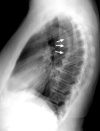Severe thoracic kyphosis in the older patient in the absence of vertebral fracture: association of extreme curve with age
- PMID: 16155162
- PMCID: PMC8148834
Severe thoracic kyphosis in the older patient in the absence of vertebral fracture: association of extreme curve with age
Abstract
Background and purpose: Limited data exist on the natural history of thoracic kyphosis in elderly patients. The purpose of this study was to determine the statistical distribution of the thoracic kyphotic angle (TKA) measurement in older patients without vertebral body abnormalities when compared with a young population.
Methods: The TKA was measured by Cobb angle on digital lateral chest radiographs in 90 patients >65 years of age, 60 patients 51-65 years of age, 67 patients 36-50 years of age, and 63 patients 18-35 years of age. Patients with vertebral compression, vertebral body angulation, congenital anomaly, or significant scoliosis were excluded.
Results: In patients >65 years of age, average TKA was 41.9 degrees , but the distribution was unexpectedly bimodal, with a low mode at 28.3 degrees and an upper mode at 51.5 degrees (P < .001). Elderly women and men independently demonstrated a bimodal TKA distribution. Two-thirds of elderly women and half of elderly men had a TKA >40 degrees (upper mode). In young patients, average TKA was 26.8 degrees . In middle-aged patients, TKA was intermediate and nonbimodal.
Conclusion: The TKA distribution in elderly patients (>65 years) without vertebral body abnormality is unexpectedly bimodal (non-normal distribution) with a subpopulation of patients significantly more affected by extreme kyphosis. Extreme thoracic kyphosis therefore occurs independently in a large subset of people, in the absence of vertebral wedge compression. The development of extreme thoracic kyphosis might contribute to excess biomechanical stress in the spine and may identify a population at risk for future vertebral compression fracture in particular at the thoracolumbar junction.
Figures








References
-
- Wehren LE. The epidemiology of osteoporosis and fractures in geriatric medicine. Clin Geriatr Med 2003;19:245–258 - PubMed
-
- Becker C. Clinical evaluation for osteoporosis. Clin Geriatr Med 2003;19:299–320 - PubMed
-
- Rosen CJ. Pathophysiology of osteoporosis. Clin Lab Med 2000;20:455–469 - PubMed
-
- Dempster DW. The pathophysiology of bone loss. Clin Geriatr Med 2003;19:259–270 - PubMed
-
- Jensen ME, Dion JE. Percutaneous vertebroplasty in the treatment of osteoporotic compression fractures. Neuroimag Clin N Am 2000;10:547–568 - PubMed
MeSH terms
LinkOut - more resources
Full Text Sources
Medical
